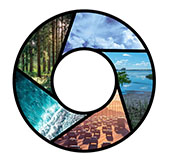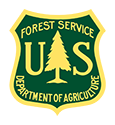Gallery of Carbon Cycle Science Research Sites, Activities and Technologies
CCSP Author Presents at ICDC
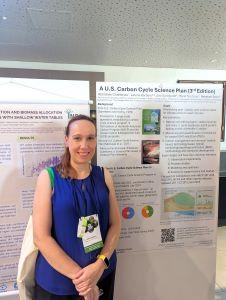
One of the lead authors of the 3rd Decadal Carbon Cycle Science Plan, Leticia Barbero, presents a poster on the U.S. Carbon Cycle Science Plan to an international audience at the International Carbon Dioxide Conference (11)in Manaus, Amazonas, Brasil in July 2024.
Sampling Koyukuk River
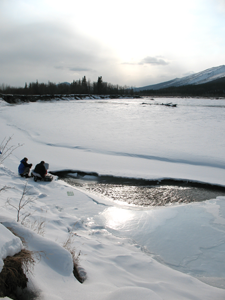
Scientists sampling dissolved organic carbon and carbon dioxide in the Koyukuk River, Alaska. (Photo credit: Mark Waldrop, USGS)
Measuring Soil CO2 Exchange

USGS graduate students measuring soil carbon dioxide exchange with CO2 flux chambers at the Nome Creek Research Watershed, Alaska. (Photo credit: Kim Wickland, USGS)
Gulkana Glacier Meltwater Sampling
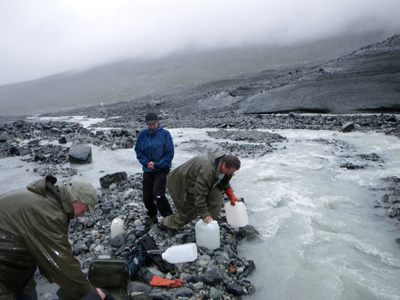
Gulkana Glacier meltwater sampling in Alaska for dissolved organic carbon and other chemical analyses at USGS laboratories in Boulder, Co. See related publications here. (Photo credit: Rob Striegl, USGS.)
Indianapolis Flux Project (INFLUX) Tower
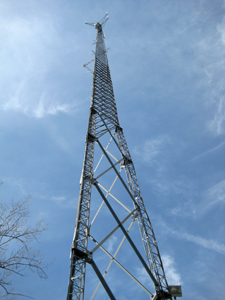
Tower at which greenhouse gases are measured as part of the Indianapolis Flux Expriment (INFLUX). INFLUX was designed to develop and evaluate methods for measurement and modeling of greenhouse gas fluxes in urban invironments. Determination of these fluxes and their uncertainty bounds is essential for the evaluation of the effectiveness of mitigation strategies. The current INFLUX ground-based observation network includes twelve in-situ tower-base, continuous measurements of a combination of CO2, CO, and CH4, in addition to a suite of other measurements, data products, and modeling efforts. INFLUX in funded by the National Insitute of Standards and Technology (NIST). See more information. (Photo credit: N. Miles.)
USGS Aquatic Carbon Sensor
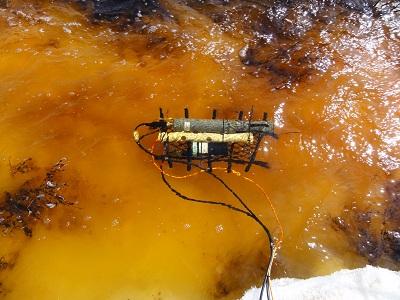
Sensors deployed by USGS in West Twin Creek, Alaska measuring dissolved organic carbon, dissolved carbon dioxide, temperature, pH, and electrical conductivity of carbon rich runoff at ice melt. (Photo credit: Mark Dornblaser, USGS.)
Fibric Surface Organic Material
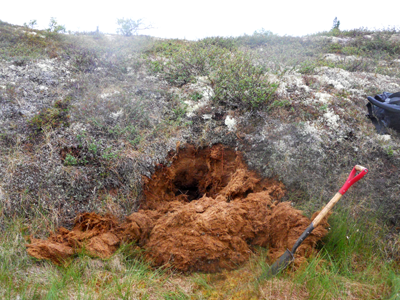
Quantifying the carbon content of fibric surface organic material located within the permafrost-rich, polygonal-tundra landscape of the Yukon-Kuskokwim Delta, Alaska. (Photo credit: Zhiliang Zhu, USGS.) Some related publications include: a) McGuire, A. D., Genet, H., He, Y., Stackpoole, S., DíAmore, D., Rupp, T. S., ... & Zhu, Z. Alaska Carbon Balance. Baseline and Projected Future Carbon Storage and Greenhouse-Gas Fluxes in Ecosystems of Alaska, 189. b) Genet, H., He, Y., Lyu, Z., McGuire, A. D., Zhuang, Q., Clein, J., ... & Zhu, Z. (2018). The role of driving factors in historical and projected carbon dynamics of upland ecosystems in Alaska. Ecological Applications, 28(1), 5-27. c) Tan, Z., Tieszen, L. L., Zhu, Z., Liu, S., & Howard, S. M. (2007). An estimate of carbon emissions from 2004 wildfires across Alaskan Yukon River Basin. Carbon balance and management, 2, 1-8.
Cavity Ring-Down Spectroscopic Instrument Measuring Greenhouse Gases
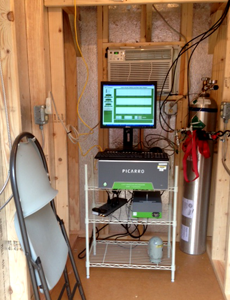
Cavity ring-down spectroscopic instrument measuring greenhouse gases as part of the Indianapolis Flux project (INFLUX). INFLUX was designed to develop and evaluate methods for measurment and modeling of greenhouse gas fluxes in urban invironments. Determination of these fluxes and their uncertainty bounds is essential for the evaluation of the effectiveness of mitigation strategies. The current INFLUX ground-based observation network includes twelve in-situ tower-based, continuous measurements of a combination of CO2, CO, and CH4, in addition to a suite of other measurements, data products, and modeling efforts. INFLUX is funded by the National Institute of Standards and Technology (NIST). See more information. (Photo credit: N. Miles.)
